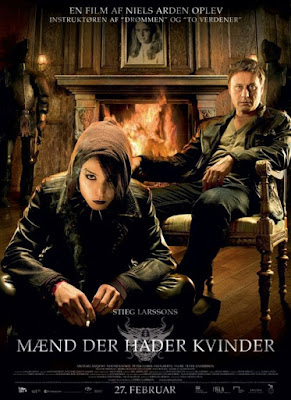Stieg Larsson's
Millennium series became quite famous this past decade. His posthumously published works quickly became bestsellers, received many crime thriller
awards, aroused public interest in an
unfinished manuscript that would allow the series to continue sans ghostwriter, and even spawned a number of silver screen adaptations. Swedish film company
Yellow Bird and Danish production agency
Nordisk Film co-produced what eventually turned into a six part mini-series back in 2009, bringing all three novels to theaters. The series was majorly successful and was later released as extended editions in trilogy format. Two years later, Yellow Bird partnered with
MGM and
Columbia Pictures to make an English adaptation of the first book in the series (the other two are still in development).
 |
Rated R for disturbing violent content, sexual material, nudity, and language.
|
So...why remake a set of movies that came out not two years before? Well, money, of course. The
Millennium bandwagon is a lucrative one, and having an A-lister like Daniel Craig replace a virtual unknown to US audiences for the lead role of Blomkvist was sure to boost ticket sales and line a lot of pockets in Hollywood. As a fan of the original films, I scoffed at the idea of seeing a glitzy, Americanized version whose creators put out a
spoilerific trailer catering to the attention span of a five year old on pixie sticks. Time passed. I decided to blog about the series, so to gain a fuller perspective I forced myself to watch a film which I previously assumed had tanked because the sequels never had a theatrical release. I ended up being surprised.
 |
Rated R for brutal violent content, strong sexuality, graphic nudity, and language.
Rooney Mara as Lisbeth Salander, Daniel Craig as Mikael Blomkvist.
Notice that Craig is in the forefront this time, despite the film's title.
|
The US version of
The Girl with the Dragon Tattoo is purportedly more faithful to the book, though apart from the ending the
differences between the two films are very slight. Director
David Fincher claims never to have seen the Swedish series, meaning that it is technically not a remake. Having now seen both, I must say that the locations used for Hedestad, Hedeby Island, and even the houses on the island look nearly identical...as does the cinematography. However, the atmosphere definitely has a different feel to it. Despite the longer runtime, the pace of Fincher's film is rushed, somehow making the characters seem less authentic and the mystery not as important as the actual act of bringing the main villain to justice. The use of flashbacks—while just as important to the storyline—lacked some essential clues that were included in the Swedish version. It is my belief that the more recent work is less graphically violent (apart from the scene with the cat) while its sex scenes reveal more nudity. This is surprising, mainly because it is usually the other way around where European-turned-American screenplays are concerned. The relationship between Lisbeth and Mikael is more affectionate in Fincher's interpretation, something which I found difficult to take seriously due to both Lisbeth's history and Mikael's circumstances.
 |
|
and sends the wrong message about the movie and its characters.
Good job, 'murica.
|
On whole, I actually liked Fincher's version. It was definitely not as effective as
Oplev's vision, nor do I understand why it needed to be made in the first place (or
why the title sequence is so over the top hardcore and charged with nightmare fuel, or even why everyone's accents are so strange). Nonetheless, it has its own merits—namely its accuracy in following the book and the acting prowess displayed by Rooney and yes, even Craig. Despite the source material, the 2011 movie simply
feels Westernized. I cannot pinpoint where it goes wrong exactly, but it somehow fails to capture the grittiness displayed in Scandinavian dramas like
The Killing,
Wallander,
The Bridge, or even
Lilyhammer.
Some more posters (click to enlarge).
In the ones above, Lisbeth looks independent and appears to be the main protagonist.
This is not so in the posters below
where again she is sexualized and shown as being only one half of a greater whole,
as though she needs Mikael in order to be 'complete'.
While Mikael is a very important character in the series, these posters serve to make Lisbeth seem secondary in comparison.
For further information:




